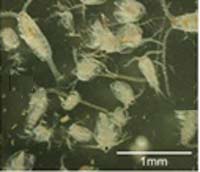
Handy Links
SLAC News Center
SLAC Today
- Subscribe
- Archives: Feb 2006-May 20, 2011
- Archives: May 23, 2011 and later
- Submit Feedback or Story Ideas
- About SLAC Today
SLAC News
Lab News
- Interactions
- Lightsources.org
- ILC NewsLine
- Int'l Science Grid This Week
- Fermilab Today
- Berkeley Lab News
- @brookhaven TODAY
- DOE Pulse
- CERN Courier
- DESY inForm
- US / LHC
SLAC Links
- Emergency
- Safety
- Policy Repository
- Site Entry Form

- Site Maps
- M & O Review
- Computing Status & Calendar
- SLAC Colloquium
- SLACspeak
- SLACspace
- SLAC Logo
- Café Menu
- Flea Market
- Web E-mail
- Marguerite Shuttle
- Discount Commuter Passes
-
Award Reporting Form
- SPIRES
- SciDoc
- Activity Groups
- Library
Stanford
Around the Bay
The Chemical Form of Mercury in the Fish We Eat
 Mercury toxicity is an environmental concern in diverse aquatic systems because methylmercury enters the water column in a number of ways and then biomagnifies through food webs. Piscivorous fish at the top of many freshwater food webs (see diagram below) can then extend that trophic transfer and potential for neurotoxcity to wildlife and humans. Mining activities, particularly those associated with the San Francisco Bay region, can generate both point and non-point mercury sources. Largemouth bass and hybrid striped bass from Guadalupe Reservoir (GUA), California and Lahontan Reservoir (LAH), Nevada were analyzed at
the Stanford Synchrotron Radiation Laboratory (SSRL) to determine predominant chemical species of mercury accumulated by high-trophic-level piscivores that are exposed to elevated mercury in both solution and particulate phases in the water column. Both GUA and LAH are affected either directly or indirectly by the legacy of gold and silver mining in the Sierra Nevadas during the 19th century.
Mercury toxicity is an environmental concern in diverse aquatic systems because methylmercury enters the water column in a number of ways and then biomagnifies through food webs. Piscivorous fish at the top of many freshwater food webs (see diagram below) can then extend that trophic transfer and potential for neurotoxcity to wildlife and humans. Mining activities, particularly those associated with the San Francisco Bay region, can generate both point and non-point mercury sources. Largemouth bass and hybrid striped bass from Guadalupe Reservoir (GUA), California and Lahontan Reservoir (LAH), Nevada were analyzed at
the Stanford Synchrotron Radiation Laboratory (SSRL) to determine predominant chemical species of mercury accumulated by high-trophic-level piscivores that are exposed to elevated mercury in both solution and particulate phases in the water column. Both GUA and LAH are affected either directly or indirectly by the legacy of gold and silver mining in the Sierra Nevadas during the 19th century.
Our results demonstrated that mercury was accumulated almost exclusively as methylmercury-cysteine complexes in the muscle tissues of piscivorous freshwater fish from both GUA and LAH. This result, consistent with observations for several marketed marine fish species, suggested that speciation of bioaccumulated mercury at high trophic levels was consistent over a wide range of ionic strengths and mercury sources. In terms of management implications, the dominance of methylmercury cysteine complexes in muscle tissues of fish obtained from such contrasting environments and exposure conditions suggest that we may be able to greatly simplify toxicological models for fish consumption over wide-ranging aquatic habitats by assuming that piscivorous fishes, a food source for wildlife and humans, consistently accumulate mercury as cysteine complexes in their tissues.
—Yuji Arai , SLAC Today, August 30, 2007
Above image: Zooplankton, above, are an important link in the chain of how mercury gets into food. (Click on image for a diagram of the transfer process.)